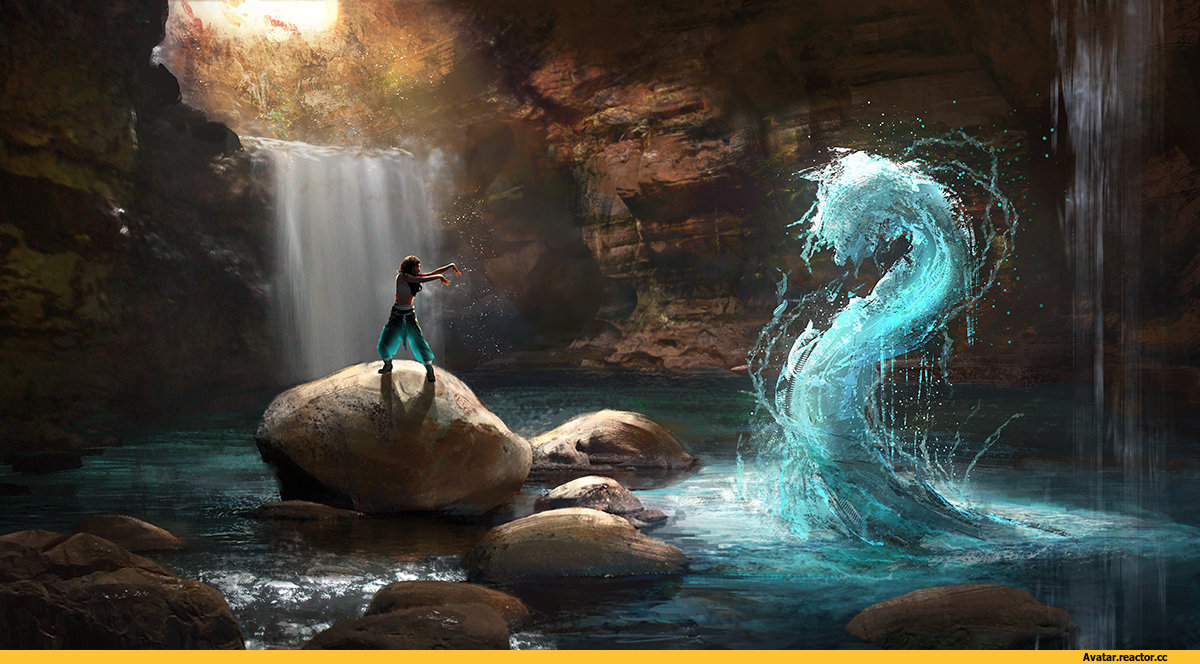Way of Waterbending
Water is the element of change. The moon is the source of power in waterbending, and the original waterbenders learned to bend by observing how the moon pushed and pulled the tides. The fighting style of waterbending is mostly fluid and graceful, acting in concert with the environment.
Waterbenders deal with the flow of energy; they let their defense become their offense, turning their opponents' own forces against them. Even when waterbenders do take an attack stance, their moves always appear to flow from one to the other.
Features
This monastic tradition grants you features at 3rd, 6th, 11th, and 17th levels. At each of these levels, you can learn a new Bending Discipline and unlock a different Chakra.
The disciplines allow you to learn magical abilities that harness the power of the chosen element. A discipline requires you to spend ki points each time you use it, unless otherwise specified. You learn a basic bending discipline and one other discipline of your choice at 3rd level. Then at 6th, 11th, and 17th levels, you gain access to a new set of disciplines and can choose an additional one. You can also replace one elemental discipline that you already know with a different discipline from the same level by meditating during a short or long rest.
The chakras grant you new advanced bending techniques. To master the element you choose, you must learn all the disciplines and unlock all of your chakras, allowing yourself to grow more powerful as you do so.
Note
Some of the spells listed here are variations of already existing spells, just modified to suit specific elements.
Waterbending Discipline I
At 3rd level, all your work finally starts to pay off and you can focus your ki to produce some waterbending tricks. You learn magical disciplines that harness the power of water. You learn the Bend Water discipline, which you always know and cannot change at later levels, plus one other waterbending discipline of your choice from the following options:
Bend Water: You can cast Shape Water at will, as a bonus action, and at a range of sight.
Glacial Armor: You can spend 2 ki points to cast Armor of Agathys.
Ice Spear: You can spend 2 ki points to cast Ice Knife.
Frozen Floor: You can spend 2 ki points to cast Ice Floor.
To cast one of these spells, you use its casting time and other rules, but you always use only somatic components, despite of the spells original components.
You can also replace one elemental discipline that you already know with a different discipline from this level by meditating during a short or long rest.
Once you reach 5th level in this class, you can spend additional ki points to increase the level of an elemental discipline spell that you cast, provided that the spell has an enhanced effect at a higher level. The spell's level increases by 1 for each additional ki point you spend. The maximum number of ki points you can spend to cast a spell in this way (including its base ki point cost and any additional ki points you spend to increase its level) is determined by your monk level, as shown in the Spells and Ki Points table.
| Monk Levels | Maximum Ki Points for a Spell |
|---|---|
| 5th-8th | 3 |
| 9th-12th | 4 |
| 13th-16th | 5 |
| 17th-20th | 6 |
Finally, Wisdom is your spellcasting ability for these spells.



Chakra of Change
When you choose this tradition at 3rd level, you officially start your journey as a waterbender. To master the element of water you must unlock all of your chakras, growing more powerful as you do so. To unlock this chakra you must spend at least 3 hours meditating (which can be taken during a long rest) and succeed on a DC 5 Wisdom check.
The first chakra you must unlock is the Chakra of Change, which is located in the palms of your hands. When you unlock this chakra, you gain a new attack option that you can use with the Attack action called the Water Whip. This special attack is a ranged attack with a range of 15 feet, and increases by 5 feet when your Martial Arts die increases. You are proficient with it, and you add your Dexterity modifier to its attack and damage rolls. This attack produces 1d4 slashing damage. This die changes as you gain monk levels, as shown in the Martial Arts column of the Monk table. When you're able to make an unarmed strike with a Monk feature such as Extra Attack or Flurry of Blows, you can replace any of the strikes with a water whip attack, but you are unable to use the Stunning Strike ability when you hit a creature with this attack.
Additionally, you can use your action to cause numbing frost to form on one creature that you can see within 30ft. The target must make a Constitution saving throw against your ki save DC. On a failed save, the target takes 1d6 cold damage, and it has disadvantage on the next weapon attack roll it makes before the end of its next turn. This damage increases by 1d6 when you reach 5th level (2d6), 11th level (3d6), and 17th level (4d6).
Waterbending Discipline II
At 6th level, your control over your waterbending technique improves. You learn another waterbending discipline of your choice from the following options:
Snowball Rain: You can spend 3 ki points to cast Snilloc's Snowball Swarm.
Swarm of Frozen Shards: You can spend 3 ki points to cast Swarm of Frozen Shards.
Freeze Person: You can spend 3 ki points to cast Freeze Person.
You can also replace one elemental discipline that you already know with a different discipline from this level by meditating during a short or long rest.
Chakra of Spirits
At 6th level, your journey as a waterbender continues. The second chakra you must unlock is the Chakra of Spirits, which is located on the back of your tights. When you unlock this chakra, you learn that water comes with a strong destructive power, but at the same time, it possesses an even greater healing power, which you can use to help the people around you. To unlock this chakra you must spend at least 6 hours meditating (which can be taken during a long rest) and succeed on a DC 10 Wisdom check.
When you unlock this chakra, you learn a new waterbending technique called the Water Cloak, with it you can use your water as a form of armor with tentacle-like arms. You can use these arms to grab objects or enemies, or to whip enemies. If a less water is available, you can simply form the arms instead of the entire cloak.
In order to use this ability you must spend 3 ki points and your action to form the water cloak and the tendrils around yourself, only 2 ki points to only form the tendrils. The number of tendrils you're able to create equals 1/2 your monk level rounded up. After that you may use your bonus action every turn to either make a water whip attack or a grapple attack against an enemy within your water whip attack range. You require one tendril to grapple a medium or smaller creature, two for a large one, three for a huge one and five for a gargantuan one. While using your water cloak, creatures no longer gain any benefit from flanking you. Finally, this technique requires your concentration, and lasts 10 minutes. If you use your flurry of blows, you may substitute any number of unarmed or water whip attacks, for grapple attacks.
Also at 6th level, you learn how to use a unique sub-skill: the ability to heal injuries by redirecting energy paths, or ki, throughout the body, using water as a catalyst. Waterbenders can use their abilities to heal by surrounding a sick or injured person with water, which glows during the process.
As an action, you can spend 3 ki points to tend to a creature and restore a number of hit points to it equal to your martial arts dice + your Wisdom modifier + additional hit points equal to the creature's maximum number of Hit Dice. You can use this ability a number of times equal to your Wisdom modifier per long rest. Alternatively, as an action, you can spend 2 ki points to cast the Lesser Restoration spell. At 11th level, you may cast Greater Restoration for 3 ki points. And at 17th level, you may cast Revivify for 5 ki points.



Ki-Empowered Bending
Starting at 6th level, you learn how to use ki to empower even your waterbending, making you even more deadly than ever before. Your bending abilities that deal bludgeoning, slashing, or piercing damage count as magical for the purpose of overcoming resistance and immunity to nonmagical attacks and damage.
Waterbend Discipline III
At 11th level, your control over your waterbending technique improves. You learn another waterbending discipline of your choice from the following options:
Sleet Storm: You can spend 4 ki points to cast Sleet Storm.
Tidal Wave: You can spend 4 ki points to cast Tidal Wave.
Wall of Water: You can spend 4 ki points to cast Wall of Water.
You can also replace one elemental discipline that you already know with a different discipline from this level by meditating during a short or long rest.



Chakra of the Tides
At 11th level, your journey as a waterbender continues. The third chakra you must unlock is the Chakra of the Tides, which is located on your eyes. This is the defining step in your journey, because at this point you truly understand the fundamentals of waterbending. One of which is the principle of redirecting an opponents attack like the flow of water. To unlock this chakra you must spend at least 12 hours meditating and succeed on a DC 15 Wisdom check.
Whenever a creature misses you with an attack you may spend 1 ki point to make an unarmed strike against that creature as a reaction.
While unlocking this chakra, you also realize that water is everywhere around you. This lets you bend all the water around you, meaning that from this point on, you no longer need to carry water around you to bend, you can instead use the water from plants, sweat, or even in the air. But this becomes a very dangerous realization, once you know that living creatures also have water in their bodies. And so the most terrifying bending technique ever was born, one so difficult it can only be performed when a waterbender is under a full moon: the art of Bloodbending.
If you are under a full moon, as an action, you may try to impose your will over another creature that has blood. Choose a creature that you can see within 60ft of you.
It must succeed on a Wisdom saving throw or be controlled by you for up to 1 minute, requiring concentration. While the creature is being puppeteered in this way, you have control over it as long as the two of you are within 60ft of each other. From then on, you can use your action to take total control of the target. Until the end of your next turn, the creature takes only the actions you choose, and doesn't do anything that you don't allow it to do, although you cannot make it cast any spells, and it uses your Wisdom modifier for any attacks or ability checks it makes while under your control. Alternatively, you can instead move the creature up to 30 feet in any direction, including upward but not beyond the range of this ability. Until the end of your next turn, the creature is restrained in your grip. A creature lifted upward is suspended in mid-air. During this time, you can also cause the creature to use a reaction, but this requires you to use your own reaction as well. At the end of each of its turns, the target can make another Wisdom saving throw. On a success, the effect ends on the target.
Bloodbending imposes a heavy toll on both the bender and the victim. After using this ability, both you and the target make another Wisdom saving throw. The DC equals 10 + the number of turns you spent bloodbending. On a failure, roll on the Short-Term Madness table. The effects last for 1d4 rounds for the bender and 1d6 for the victim.
At 17th level, you no longer need to be under a full moon to bloodbend, but it costs 5 ki points
| d100 | Effects |
|---|---|
| 01 20 | The character retreats into his or her mind and becomes paralyzed. The effect ends if the character takes any damage. |
| 21 30 | The character becomes incapacitated and spends the duration screaming, laughing, or weeping. |
| 31 40 | The character becomes frightened and must use his or her action and movement each round to flee from the source of the fear. |
| 41 50 | The character begins babbling and is incapable of normal speech or spellcasting. |
| 51 60 | The character must use his or her action each round to attack the nearest creature. |
| 61 70 | The character experiences vivid hallucinations and has disadvantage on ability checks. |
| 71 75 | The character does whatever anyone tells him or her to do that isn't obviously self-destructive. |
| 76 80 | The character experiences an overpowering urge to eat something strange such as dirt, slime, or offal. |
| 81 90 | The character is stunned. |
| 90 100 | The character falls unconscious. |



Waterbend Discipline IV
At 17th level, your control over your waterbending technique is unmatched. You learn another waterbending discipline of your choice from the following options:
Drain: You can spend 5 ki points to cast Blight.
Control Water: You can spend 5 ki points to cast Control Water.
Watery Sphere: You can spend 5 ki points to cast Watery Sphere.
You can also replace one elemental discipline that you already know with a different discipline from this level by meditating during a short or long rest.
Chakra of the Lunar Soul
At 17th level, your journey as a waterbender is in its final stages. The fourth, and last, chakra you must unlock is the Chakra of the Lunar Soul, which is located in your heart. Unlocking this chakra brings you closer than ever to the original waterbending master, the Moon, and by focusing on your ki, you can control water just like the moon pushes and pulls the tides. To unlock this chakra you must spend at least 24 hours meditating and succeed on a DC 20 Wisdom check.
As a 1 minute ritual, you can cast Tsunami. After the tsunami ends, or your concentration is broken you are stunned for 1 round and you gain 2 levels of exhaustion. You may use this ability once per long rest.
Avatar State
At 17th level, you are granted access to the infinite wisdom of the original waterbender, the Moon, which kicks in when you are in mortal danger. When you are reduced to 0 hit points, but not killed outright, you may use your reaction to enter the Avatar State and spring back to your feet.
When you do so, you gain a number of temporary hit points equal to the amount of ki points you have left (minimum of 1), after that, your number of ki points is reduced to zero, if it isn't already. Then, as part of the same reaction, you can stand up and move, up to your movement speed, without provoking attacks of opportunity.
While in this state you carry the wisdom of all the greatest waterbending masters that already passed away. Your eyes shine with a bright white light, as ice rimes your body and you gain the following benefits:
- You are immune to cold damage and have resistance to fire damage.
- You can move across difficult terrain created by ice or snow without spending extra movement.
- The ground in a 10-foot radius around you is icy and is difficult terrain for creatures other than you. The radius moves with you.
This form lasts for 1 minute, or until you fall unconscious. After the transormation, you also gain a level of exhaustion. Once you use this feature, you can't use it again until you finish a long rest.
At 20th level, you may use this transformation as an action on your turn, without gaining temporary hit points nor levels of exhaustion at the cost of 7 ki points.



Adapted Spells
Waterbending
Ice Floor
1st level, Conjuration
- Casting Time: 1 Action
- Range: 60ft
- Components: S
- Duration: 1 minute
A thin sheet of ice covers the ground in a 10-foot square centered on a point within range and turns it into difficult terrain for the duration.
When the ice appears, each creature standing in its area must succeed on a Dexterity saving throw or fall prone. A creature that enters the area or ends its turn there must also succeed on a Dexterity saving throw or fall prone.
Swarm of Frozen Shards
2nd level, Conjuration
- Casting Time: 1 Action
- Range: 60ft
- Components: S
- Duration: Concentration, up to 1 minute
You fill the air with spinning shards of jagged ice in a cube 5 feet on each side, centered on a point you choose within range. A creature takes 4d4 slashing damage when it enters the spell's area for the first time on a turn or starts its turn there.
At Higher Levels.
When you cast this spell using a spell slot of 3rd level or higher, the damage increases by 2d4 for each slot level above 2nd.
Freeze Person
2nd level, Transmutation
- Casting Time: 1 Action
- Range: 60ft
- Components: S
- Duration: Concentration, up to 1 minute
Choose a humanoid that you can see within range. The target must succeed on a Dexterity saving throw or be paralyzed for the duration. At the end of each of its turns, the target can make a Strenght saving throw. On a success, the spell ends on the target.
At Higher Levels.
When you cast this spell using a spell slot of 3rd level or higher, you can target one additional humanoid for each slot level above 2nd. The humanoids must be within 30 feet of each other when you target them.
Disclaimer
Most of the information about the philosophy and fighting styles of the bending arts in this homebrew is directly copied from the Avatar Fandom Wiki.
Image credit in order of appearance
Waterbending
Adapted Spells

